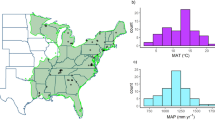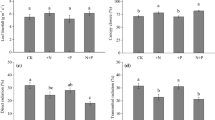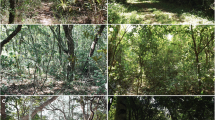Abstract
Soil nitrogen (N) supply and uptake by regenerating trees is an important ecosystem attribute but difficult to quantify in partial-cut forests where light availability varies. The foliar attributes of N concentration (N%) and N per unit area (Na) may help characterize the influence of soil nutrition, but ideally the relationship between soils and foliage would be tested separately by species across well-defined light gradients. To do this, we examined foliar attributes of four tree species across gradients of light availability in 12 year-old partially-cut forests in northwest British Columbia, Canada. There were no differences in forest floor or mineral soil N mineralization rates across the light gradients, and for western hemlock (Tsuga heterophylla) and hybrid white spruce (Picea glauca x sitchensis), this consistent level of soil N supply corresponded with unchanging foliar N%. In contrast, foliar N% of Betula papyrifera (paper birch) and Thuja plicata (western redcedar) declined with shading, perhaps due to shifts in root-shoot biomass allocation for B. papyrifera, and climatic constraints on shade tolerance for T. plicata. Leaf δ13C approached an asymptote at approx. 40% full light for the coniferous species, but increased linearly with light for B. papyrifera. Foliar Na was linearly correlated with leaf δ13C for three species, reflecting the dual effect of light and nutrition on photosynthesis processes, and suggesting that foliar Na may be a simple parameter to integrate both resource constraints on regenerating saplings. These results demonstrate both support for and limits to foliar attributes among species in isolating soil N effects against light constraints in partial-cut forests.





Similar content being viewed by others
References
Banner A, MacKenzie W, Haeussler S, Thomson S, Pojar J, Trowbridge R (1993) A field guide to site identification and interpretation for the Prince Rupert Forest Region. MOF Field Handbook 26. Crown, Victoria, B.C
Binkley D, Hart SC (1989) The components of nitrogen availability assessments in forest soils. Adv Soil Sci 10:57–112
Broadmeadow MSJ, Griffiths H (1993) Carbon isotope discrimination and the coupling of CO2 fluxes within forest canopies. In: Ehleringer JR, Hall AE, Farquhar GD (eds) Stable isotopes and plant carbon-water relations. Academic, San Diego, CA, pp 109–129
Brooks JR, Flanagan LB, Buchmann N, Ehleringer JR (1997) Carbon isotope composition of boreal plants: functional grouping of life forms. Oecologia 110:301–311
Brown KR, Thompson WA, Camm EL, Hawkins BJ, Guy RD (1996) Effects of N addition rates on the productivity of Picea sitchensis, Thuja plicata, and Tsuga heterophylla seedlings. II. Photosynthesis, 13C discrimination and N partitioning in foliage. Trees 10:198–205
Buchmann N, Kao W-Y, Ehleringer JR (1997) Influence of stand structure on carbon-13 of vegetation, soils, and canopy air within deciduous and evergreen forests in Utah, United States. Oecologia 110:109–119
Buchmann N, Brooks JR, Ehleringer JR (2002) Predicting day-time carbon isotope ratios of atmospheric CO2 within forest canopies. Funct Ecol 16:49–57
Burgess SSO, Dawson TE (2007) Predicting the limits to tree height using statistical regressions of leaf traits. New Phytol 174:626–636
Catovsky S, Bazzaz FA (2002a) Nitrogen availability influences regeneration of temperate tree species in the understory seedling bank. Ecol Appl 12:1056–1070
Catovsky S, Kobe RK, Bazzaz FA (2002b) Nitrogen-induced changes in seedling regeneration and dynamics of mixed conifer-broad-leaved forests. Ecol Appl 12:1611–1625
Coates KD, Burton PJ (1997) A gap-based approach for development of silvicultural systems to address ecosystem management objectives. For Ecol Manage 99:337–354
Coates KD, Burton PJ (1999) Growth of planted seedlings in response to ambient light levels in northwestern interior cedar-hemlock forests of British Columbia. Can J For Res 29:1374–1382
Coates KD, Banner A, Steventon JD, LePage P, Bartemucci P (1997) The Date Creek silvicultural systems study in the interior cedar-hemlock forests of northwestern British Columbia: Overview and treatment summaries. B.C. Min. For. Land Man. H
Coates KD, Canham CD, Beaudet M, Sachs DL, Messier C (2003) Use of a spatially explicit individual-tree model (SORTIE BC) to explore the implications of patchiness in structurally complex forests. For Ecol Manage 186:297–310
Dawson TE, Mambelli S, Plamboeck AH, Templer PH, Tu KP (2002) Stable isotopes in plant ecology. Annu Rev Ecol Syst 33:507–559
Duursma RA, Marshall JD (2006) Vertical canopy gradients in δ13C correspond with leaf nitrogen content in a mixed-species conifer forest. Trees 20:496–506
Duursma RA, Marshall JD, Nippert JB, Chambers CC, Robinson AP (2005) Estimating leaf-level parameters for ecosystem process models: a case study in mixed conifer canopies on complex terrain. Tree Physiol 25:1347–1359
Farquhar GD, Ehleringer JR, Hubick KT (1989) Carbon isotope discrimination and photosynthesis. Ann Rev Plant Physi Plant Mol Biol 40:503–537
Frazer GW, Canham CD, Lertzman KP (2000) Gap Light Analyzer, Version 2.0. Bull Ecol Soc Amer 81:191–197
Grassi G, Bagnaresi U (2001) Foliar morphological and physiological plasticity in Picea abies and Abies alba saplings along a natural light gradient. Tree Physiol 21:959–967
Gray AN, Spies TA, Easter MJ (2002) Microclimatic and soil moisture responses to gap formation in coastal Douglas-fir forests. Can J For Res 32:332–343
Green RN, Trowbridge RL, Klinka K (1993) Towards a taxonomic classification of humus forms. For Sci Mono 29:1–48
Grenon F, Bradley RL, Jones M, Shipley B (2005) Soil factors controlling mineral N uptake by Picea engelmannii seedlings: the importance of gross NH +4 production rates. New Phytol 165:791–800
Guy RD, Holowachuk DL (2001) Population differences in stable carbon isotope ratio of Pinus contorta Dougl. ex Loud.: relationship to environment, climate of origin and growth potential. Can J Bot 79:274–283
Hart SC, Stark JM, Davidson EA, Firestone MK (1994) Nitrogen mineralization, immobilization, and nitrification. In Weaver RV et al. (ed) Methods of soil analysis. Part 2—Microbiological and biochemical properties. SSSA Book Series 5, pp 985–1018
Högberg MN, Myrold DD, Giesler R, Högberg P (2006) Contrasting patterns of soil N-cycling in model ecosystems of Fennoscandian boreal forests. Oecologia 147:96–107
SAS Institute Inc (2004) SAS OnlineDoc® 9.1.3. Cary, NC, USA
Jerabkova L, Prescott CE, Kishchuk BE (2006) Effect of variable retention harvesting on soil nitrogen availability in boreal mixedwood forests. Can J For Res 36:3029–3038
Kaelke CM, Kruger EL, Reich PB (2001) Trade-offs in seedling survival, growth, and physiology among hardwood species of contrasting successional status along a light availability gradient. Can J For Res 31:1602–1616
Kalra YP, Maynard DG (1991) Methods manual for forest soil and plant analysis; Forestry Canada, Northwest Region, Northern Forestry Centre, Edmonton, AB. Information Report NOR-X-319. p 116
Katahata S-I, Naramoto M, Kakubari Y, Mukai Y (2007) Photosynthetic capacity and nitrogen partitioning in foliage of the evergreen shrub Daphniphyllum humile along a natural light gradient. Tree Physiol 27:199–208
Kazda M, Salzer J, Schmid I, Von Wrangell P (2004) Importance of mineral nutrition for photosynthesis and growth of Quercus petraea, Fagus sylvatica and Acer pseudoplantanus planted under Norway spruce canopy. Plant Soil 264:25–34
Kloeppel BD, Gower ST, Vogel JG, Reich PB (2000) Leaf-level resource use for evergreen and deciduous conifers along a resource availability gradient. Func Ecol 14:281–292
Kobe RK (2006) Sapling growth as a function of light and landscape-level variation in soil water and foliar nitrogen in northern Michigan. Oecologia 147:119–133
Körner C (1989) The nutritional status of plants from high altitudes. Oecologia 81:379–391
Kranabetter JM, Coates KD (2004) Ten-year postharvest effects of silviculture systems on soil-resource availability and conifer nutrition in a northern temperate forest. Can J For Res 34:800–809
Kranabetter JM, Simard SW (2008) Inverse relationship between understory light and foliar nitrogen along productivity gradients of boreal forests. Can J For Res 38:2487–2496
Kranabetter JM, Banner A, Shaw J (2003) Growth and nutrition of three conifer species across site gradients of north coastal British Columbia. Can J For Res 33:313–324
Lapointe B, Bradley R, Parsons W, Brais S (2006) Nutrient and light availability to white spruce seedlings in partial and clearcut harvested aspen stands. Silva Fennica 40:459–471
Le Roux X, Bariac T, Sinoquet H, Genty B, Piel C, Mariotti A, Girardin C, Richard P (2001) Spatial distribution of leaf water-use efficiency and carbon isotope discrimination within an isolated tree crown. Plant Cell Environ 24:1021–1032
Lusk CH, Reich PB (2000) Relationships of leaf dark respiration with light environment and tissue nitrogen content in juveniles of 11 cold-temperature tree species. Oecologia 123:318–329
Machado J-L, Walters MB, Reich PB (2003) Below-ground resources limit seedling growth in forest understories but do not alter biomass distribution. Ann For Sci 60:319–330
Man RZ, Lieffers VJ (1997) Seasonal photosynthetic responses to light and temperature in white spruce seedlings planted under an aspen (Populus tremuloides) canopy and in open conditions. Tree Physiol 17:437–444
Marshall JD, Zhang J (1994) Carbon isotope discrimination and water-use efficiency in native plants of the north-central Rockies. Ecology 75:1887–1895
Messier C, Doucet R, Ruel J-C, Claveau Y, Kelly C, Lechowicz MJ (1999) Functional ecology of advance regeneration in relation to light in boreal forests. Can J For Res 29:812–823
Mitchell AK, Arnott JT (1995) Effects of shade on the morphology and physiology of amabilis fir and western hemlock seedlings. New Forests 10:79–98
Mitchell AK, Koppenaal R, Goodmanson G, Benton R, Bown T (2007) Regenerating montane conifers with variable retention systems in a coastal British Columbia forest: 10-year results. For Ecol Manage 246:240–250
Niinemets Ü (1997a) Distribution patterns of foliar carbon and nitrogen as affected by tree dimensions and relative light conditions in the canopy of Picea abies. Trees 11:144–154
Niinemets Ü (1997b) Role of foliar nitrogen in light harvesting and shade tolerance of four temperate deciduous woody species. Funct Ecol 11:518–531
Niinemets Ü (1998) Growth of young trees of Acer platanoides and Quercus robur along a gap-understory continuum: interrelationships between allometry, biomass partitioning, nitrogen, and shade tolerance. Int J Plant Sci 159:318–330
Niinemets Ü (2006) The controversy over traits conferring shade-tolerance in trees: ontogenetic changes revisited. J Ecol 94:464–470
Niinemets Ü, Kull O, Tenhunen JD (1998) An analysis of light effects on foliar morphology, physiology, and light interception in temperate deciduous woody species of contrasting shade tolerance. Tree Physiol 18:681–696
Niinemets Ü, Portsmuth A, Truus L (2002) Leaf structural and photosynthetic characteristics, and biomass allocation to foliage in relation to foliar nitrogen content and tree size in three Betula species. Ann of Bot 89:191–204
Prescott CE (2002) The influence of the forest canopy on nutrient cycling. Tree Physiol 22:1193–1200
Radwan MA, Harrington CA (1986) Foliar chemical concentrations, growth, and site productivity relations in western red cedar. Can J For Res 16:1069–1075
Reich PB, Kloeppel BD, Ellsworth DS, Walters MB (1995) Different photosynthesis-nitrogen relations in deciduous hardwood and evergreen coniferous species. Oecologia 104:24–30
Reich PB, Walters MB, Ellsworth DS (1997) From tropics to tundra: global convergence in plant functioning. Proc Nat Acad Sci 94:13730–13734
Reich PB, Ellsworth DS, Walters MB (1998) Leaf structure (specific leaf area) modulates photosynthesis-nitrogen relationships: evidence from within and across species and functional groups. Funct Ecol 12:948–958
Rijkers T, Pons TL, Bongers F (2000) The effect of tree height and light availability on photosynthetic leaf traits of four neotropical species differing in shade tolerance. Funct Ecol 14:77–86
Schimel JP, Bennett J (2004) Nitrogen mineralization: challenges of a changing paradigm. Ecology 85:591–602
Soil Classification Working Group (1998) The Canadian system of soil classification, 3rd ed. Agriculture and Agri-Food Canada Publication 1646, p 187
Sternberg LSL, Mulkey SS, Wright SJ (1989) Ecological interpretation of leaf carbon isotope ratios: influence of respired carbon dioxide. Ecology 70:1317–1324
Sun ZJ, Livingston NJ, Guy RD, Ethier GJ (1996) Stable carbon isotopes as indicators of increased water use efficiency and productivity in white spruce (Picea glauca [Moench] Voss) seedlings. Plant Cell Environ 19:887–894
Takashima T, Hikosaka K, Hirose T (2004) Photosynthesis or persistence: nitrogen allocation in leaves of evergreen and deciduous Quercus species. Plant Cell Env 27:1047–1054
Titus BD, Prescott CE, Maynard DG, Mitchell AK, Bradley RL, Feller MC, Beese WJ, Seely BA, Benton RA, Senyk JP, Hawkins BJ, Koppenaal R (2006) Post-harvest nitrogen cycling in clearcut and alternative silvicultural systems in a montane forest in coastal British Columbia. For Chron 82:844–859
Walters MB, Lajzerowicz CC, Coates KD (2006) Soil resources and the growth and nutrition of tree seedlings near harvest gap—forest edges in interior cedar-hemlock forests of British Columbia. Can J For Res 36:62–76
Wang GG, Klinka K (1997) White spruce foliar nutrient concentrations in relation to tree growth and soil nutrient amounts. For Ecol Manage 98:89–99
Warren C, Adams M (2004) Evergreen trees do not maximize instantaneous photosynthesis. Trend Plant Sci 9:270–274
Warren C, Dreyer E, Adams M (2003) Photosynthesis-rubisco relationships in foliage of Pinus sylvestris in response to nitrogen supply and the proposed role of rubisco and amino acid as nitrogen stores. Trees 17:359–366
Wolf DC, Legg JO, Boutton TW (1994) Isotopic methods for the study of soil organic matter dynamics. In: Weaver R (ed) Methods of soil analysis: 2. Microbiological and biochemical properties. Soil Science Society of America, No. 5, Madison, Wisconsin, U.S.A, pp 865–906
Wright I, Reich PB, Westoby M, Ackerly DD et al (2004) The worldwide leaf economics spectrum. Nature 428:821–827
Yin X (1993) Variation in foliar nitrogen concentration by forest type and climatic gradients in North America. Can J For 23:1587–1602
Acknowledgements
We thank Marcel Lavigne for assisting in the field sampling and preparation of soils and foliage for analysis. Clive Dawson and Dave Dunn from the B.C. Ministry of Forests Analytical laboratory undertook the foliar and soil chemical analysis. Peter Ott of the B.C. Ministry of Forests was consulted on the statistical analysis. Kathy Gordon from the University of British Columbia provided foliar isotope analysis. Roy Turkington, Cindy Prescott and the anonymous reviewers provided useful comments on an earlier draft of the manuscript. Funds for the research project were provided by the B.C. Ministry of Forests and the Forest Investment Account of British Columbia.
Author information
Authors and Affiliations
Corresponding author
Additional information
Responsible Editor: Alfonso Escudero.
Rights and permissions
About this article
Cite this article
Kranabetter, J.M., Simard, S.W., Guy, R.D. et al. Species patterns in foliar nitrogen concentration, nitrogen content and 13C abundance for understory saplings across light gradients. Plant Soil 327, 389–401 (2010). https://doi.org/10.1007/s11104-009-0062-6
Received:
Accepted:
Published:
Issue Date:
DOI: https://doi.org/10.1007/s11104-009-0062-6




